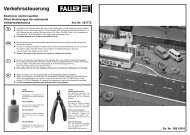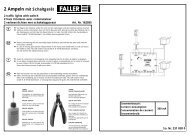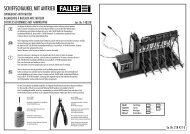INSTRUCTION MANUAL
INSTRUCTION MANUAL
INSTRUCTION MANUAL
Create successful ePaper yourself
Turn your PDF publications into a flip-book with our unique Google optimized e-Paper software.
Page 56<br />
Decoder MX620 - MX622, MX630 - MX632 Sound Decoder MX640 - MX648<br />
7 MX631C, MX632C, MX640C, MX642C for C-Sinus (Softdrive)<br />
The MX631C, MX632C, MX640C and MX642C are made especially for Märklin and Trix engines<br />
with C-Sinus motors and are equipped with a 21-pin interface. The decoder also supplies the necessary<br />
5V the C-Sinus board needs to operate (which „normal“ decoders are not capable of!).<br />
The C-type decoder can be used, regardless of the type of motor, for Märklin, Trix and Märklin<br />
compatible engines which cannot process normal functions on function output FO3 and FO4, but<br />
require logic level outputs instead.<br />
The C-type decoders differ from the normal 21-pin plug (MX631D, MX632D, MX640D, MX642D) in<br />
the use of output pins FO3 and FO4. The D version has normal (amplified) outputs on these pins<br />
while the C version has logic level outputs. These logic level outputs supply the needed 5V for activating<br />
the C-Sinus or Softdrive loco board or for the selection between the front to rear power pickup,<br />
which is installed in many vehicles.<br />
The MX631C, MX632C (or MX640C, MX642C sound decoder) is plugged into the pins of the loco<br />
board with the top side of the decoder pointing up, whereby the pins are being pushed through the<br />
decoder board in order to make contact with the decoder socket. The position is given by the loco<br />
board and is also keyed by the missing pin 11 (on the loco board) and missing hole in the same location<br />
on the decoder board.<br />
The picture below shows a sample layout; the loco board may however vary from case to case.<br />
CAUTION:<br />
Unfortunately, Märklin/Trix has played a “dirty trick” (although probably not on purpose): Beginning<br />
with a specific model or past a certain date, the protective resistors on the loco board input side have<br />
been omitted, or more precisely, instead of the 100kO resistors useless 0 Ohm resistors are being<br />
installed. The resulting voltage is too high for the loco board which will not only destroy the board but<br />
can also damage the decoder, unless the decoder has been switched to the C-Sinus mode before<br />
being plugged in with CV #145 = 10 or 12.<br />
But even if CV #145 = 10 or 12 is set first, there is no guarantee that the loco board with 0<br />
Ohm resistors will survive in the long run (even though there is no visible problem at the<br />
moment)!<br />
Background information: Although the 21-pin interface in Märklin and Trix locomotives is virtually<br />
identical to the standardized NMRA-DCC 21-pin interface, Märklin keeps modifying it whenever the<br />
need arises (several versions, “misapplication” of function outputs for motor activation and now the<br />
mentioned electrical input changes); their own brand decoder is the only one that is being taken into<br />
account through all this. The installation of other brand decoders is obviously not desired…<br />
CORRECTIVE MEASURE: The MX631C, MX632C or MX640C, MX642C must not be installed if<br />
zero-ohm resistors (markings “000”) are found on the loco board in place of actual protective resistors<br />
(markings “104”). It is imperative that these are being replaced with 100KO resistors (“104”)<br />
before installing the decoder. Relevant ZIMO decoders will be shipped with the necessary resistors.<br />
Loco board with 21-pin plug and MX632C plugged in<br />
Flat ribbon cable to C-Sinus motor<br />
Before plugging in the decoder, check the C-Sinus board whether it contains 0-Ohm resistors; see<br />
CAUTION on the next page!!<br />
MX631C, 632C and MX640C, MX642C are “normal” decoders for “normal” motors except for the<br />
function outputs FO3 and FO4, which can be switched to C-Sinus motor control by programming:<br />
CV #145 = 10 if the engine originally came with a Märklin/Trix decoder or CV #145 = 12 if the original<br />
decoder was from ESU (recognizable by a blue circuit board).<br />
With the help of CV #145 the decoder can also be configured for some special versions, which becomes<br />
necessary due to different decoder interface layouts on the part of Märklin/Trix, see CV table!<br />
Locomotives equipped with C-Sinus capable ZIMO decoders can be operated in the NMRA-DCCdata<br />
format as well as the MOTOROLA protocol, but not in analog mode (DC)!<br />
No motor regulation, known as BEMF, takes place when the decoder operates in the C-Sinus mode,<br />
since the motor tries to keep the target speed precisely in all situations. The relevant configuration<br />
variables, among them CV #9, #56 and #58, are without effect!<br />
Above is a picture showing a loco board with the useless (“000”) resistors; in such cases it is not allowed<br />
to plug in a MX631C, MX632C… decoder!<br />
Due to the many different C-Sinus boards that have been produced it is impossible for us to provide<br />
precise information about the location of these resistors on each board. Because the resistors may<br />
be mounted in different locations on the board in your engine, we would suggest that you find them<br />
by following the traces. First study the picture below. The blue and pink arrows are pointing out the<br />
traces that connect these resistors with the processor. Note the processor pins those tracers are<br />
leading to.










